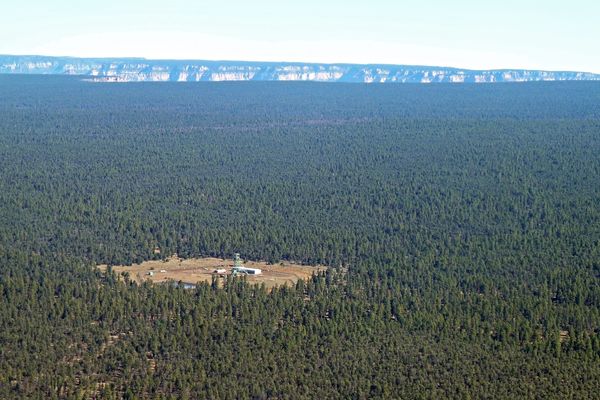
- Details
- By Native News Online Staff
Grand Canyon National Park, ARIZ. — Mining activity near the Grand Canyon National Park has recently been reported fewer than 10 miles from the south rim of the Grand Canyon, said the Havasupai Tribe in a statement today.
The Havasupai Tribe has been opposed to any mining activity near the Grand Canyon, where the Tribe is located, for decades.
“It is time to permanently ban uranium mining — not only to preserve the Havasupai Tribe’s cultural identity and our existence as the Havasupai People but to protect the Grand Canyon for generations to come,” Havasupai Tribal Chairman Thomas Siyuja, Sr. said in a statement. “With recent activity observed inside the mine fence, it is clear that the mining company is making plans to begin its operations.”
The Tribe and its allies say hundreds of uranium mines could eventually be developed on federal public lands near the Grand Canyon National Park if efforts fail to pass the Senate Bill 387 — Grand Canyon Protection Act. The bill is currently in the Senate and, if passed, would permanently ban new uranium mines on more than 1 million acres of federal public lands near the Grand Canyon. The bill has already passed in the House of Representatives twice, according to the Grand Canyon Trust, a nonprofit organization that is dedicated to the preservation of the Grand Canyon and the Colorado Plateau and promoting the rights of Native peoples in the region.
The Pinyon Plain Mine, formerly known as the Canyon Mine, posted job advertisements on Craigslist two weeks ago, reported the Grand Canyon Trust.
“Pinyon Plain Mine remains a shameful example of why the Grand Canyon region must be permanently protected from further mining,” Grand Canyon Trust’s Energy Director Amber Reimondo said in a statement. “For over 30 years, the Havasupai Tribe has been clear about the harm this mine causes. Yet regulators still focus only on when and how to allow it, rather than whether this uranium mine should be allowed at all.”
Pinyon Plain Mine is located in the Kaibab National Forest, near Red Butte, which is a federally recognized traditional cultural property south of the Grand Canyon National Park. The area is the homeland of the Havasupai Tribe, and the mine threatens the Tribe’s only source of drinking water. The Havasupai Tribe has led opposition to the mine since it was first approved in the 1980s.
“The Havasupai Tribe knows the irreparable damage that uranium mining can do,” Havasupai Tribal Chairman Siyuja said in a statement. “For generations, we have been at the forefront, working to permanently protect our ancient homelands from the negative impacts of uranium mining, which has disproportionately harmed and sickened indigenous people across Northern Arizona. The Senate must pass the Grand Canyon Protection Act and once and for all permanently ban any new uranium mines on our ancestral lands.”
Want more Native News? Get the free daily newsletter today.
While the passage of the Grand Canyon Protection Act would stop new mines from being developed, it would not shut down existing mines like Pinyon Plain Mine. The Havasupai Tribe and its many supporters remain committed to seeing the mine closed and cleaned up.
Uranium mining has a long history of contaminating land and water in Indian Country, including on the Navajo Nation, where hundreds of uranium mines were abandoned without cleanup. Native News Online reported in April 2022 that the U.S. Nuclear Regulatory Commission traveled to the Navajo Nation to hear of the effects of uranium mining on the reservation for the first time in history.
More Stories Like This
Trump signs law that revokes some limits on drilling in Alaska’s National Petroleum ReserveSouthern Sierra Miwuk Nation Gets 900-Acres ofLand Back
Chilkat Indian Village Tells New Palmer Mine Owners They Are “Not Welcome” in Chilkat Valley
Tribes, Coastal Group Ask Army Corps to Revoke Permit for Texas Export Terminal
Michigan Tribes Tell Supreme Court: Don’t Bail Out Enbridge
Help us defend tribal sovereignty.
At Native News Online, our mission is rooted in telling the stories that strengthen sovereignty and uplift Indigenous voices — not just at year’s end, but every single day.
Because of your generosity last year, we were able to keep our reporters on the ground in tribal communities, at national gatherings and in the halls of Congress — covering the issues that matter most to Indian Country: sovereignty, culture, education, health and economic opportunity.
That support sustained us through a tough year in 2025. Now, as we look to the year ahead, we need your help right now to ensure warrior journalism remains strong — reporting that defends tribal sovereignty, amplifies Native truth, and holds power accountable.
 The stakes couldn't be higher. Your support keeps Native voices heard, Native stories told and Native sovereignty defended.
The stakes couldn't be higher. Your support keeps Native voices heard, Native stories told and Native sovereignty defended.
Stand with Warrior Journalism today.
Levi Rickert (Potawatomi), Editor & Publisher

